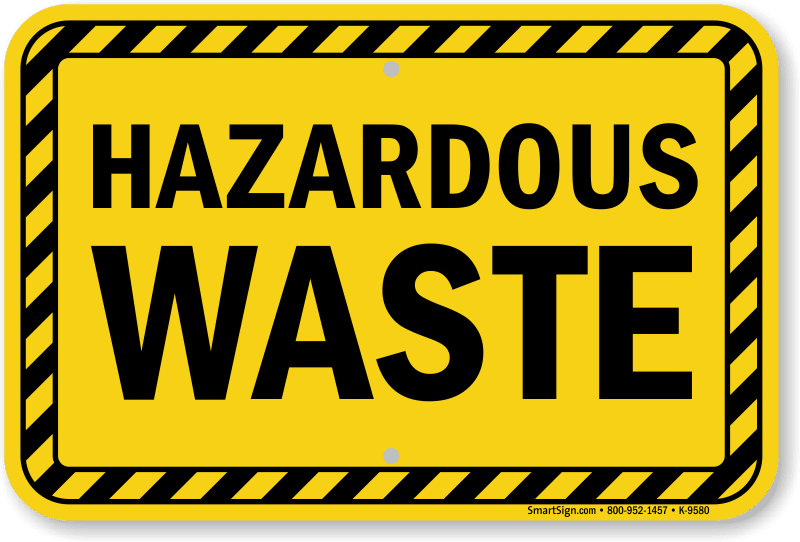Hazardous waste sign
 The hazardous waste sign is used to warn people of the dangers of improperly handling or disposing of hazardous materials. They typically include a symbol that represents the type of hazard, as well as written warnings.
The hazardous waste sign is used to warn people of the dangers of improperly handling or disposing of hazardous materials. They typically include a symbol that represents the type of hazard, as well as written warnings.
There are many different types of hazardous waste sign, but some of the most common ones include:
Danger signs: These signs are used to warn people of the most serious hazards, such as explosives or flammable materials.
Warning signs: These signs are used to warn people of less serious hazards, such as irritants or toxins.
Caution signs: These signs are used to warn people of potential hazards, but the risks are not as severe as those associated with danger or warning signs.
The list of Meterials of Danger Hazardous waste sign:
Material: The sign itself can be made from various materials depending on its intended location and durability needs. Some common options include:
Rigid plastic – Affordable and weatherproof for outdoor use.
Aluminum – More durable than plastic and can withstand harsher conditions.
Self-adhesive vinyl – Easy to apply to flat surfaces indoors.
Wording: The sign will prominently display “Danger” in bold lettering to indicate the high-hazard level.
Pictogram: This is the key element that communicates the specific type of hazard. Since “hazardous” is a general term, the pictogram will provide more specific information. Here are some common pictograms used on hazardous material signs:
Flame: Flammable materials (e.g., gasoline, propane)
Skull and crossbones: Toxic materials (e.g., pesticides, arsenic)
Exploding bomb: Explosives (e.g., dynamite, fireworks)
Corrosion symbol (liquids dripping onto a metal surface): Corrosive materials (e.g., acids, lye)
Exclamation mark: This is a general warning symbol used for various hazards that don’t have a specific pictogram (e.g., biohazards, irritants).
The list of materials of hazardous warning sign:
The materials used for a hazardous warning sign can be broken down into two categories:
Sign Substrate: This is the physical material the sign itself is made from and depends on factors like location and durability needs. Here are some common options:
Rigid plastic: This is a cost-effective option that’s weatherproof and suitable for outdoor use. It’s lightweight and easy to handle during installation.
Aluminum: This is a more durable option compared to plastic. It can withstand harsher weather conditions and resist scratches or dents better.
Self-adhesive vinyl: This is a flexible material that’s easy to apply to flat surfaces indoors. It’s not ideal for outdoor use as it may not weather well.
Sign Lettering and Pictogram:
Paint or Ink: The lettering and pictogram on the sign are typically applied using weatherproof paint or ink suitable for outdoor use.
Reflective Materials: In some cases, reflective materials might be incorporated to enhance visibility in low-light conditions. This is especially important for outdoor signs.
Vinyl Lettering or Decals: Pre-made vinyl lettering or decals featuring the hazard pictogram and wording can be applied to the sign substrate. This offers a clean and professional look.
Additional Considerations:
Regulations: In some workplaces or areas, there might be specific regulations regarding the materials used for hazardous warning signs. These regulations may dictate factors like sign strength, fire resistance, or visibility.
Durability: Consider the intended location of the sign. Will it be exposed to harsh weather conditions, chemicals, or high temperatures? Choose a material that can withstand the environment.
Cost: Rigid plastic is generally the most affordable option, while aluminum and reflective materials are more expensive.
The list of materials of hazardous caution sign:
Similar to danger and warning signs, hazardous caution signs can be made from a variety of materials depending on their intended location and durability needs. Here’s a breakdown of the materials typically used:
Sign Substrate:
Rigid plastic: This is the most common and cost-effective option for caution signs. It’s lightweight, weatherproof, and suitable for outdoor use.
Aluminum: A more durable choice than plastic, aluminum signs can withstand harsher environments and resist scratches or dents better.
Self-adhesive vinyl: This is a flexible material ideal for indoor application on flat surfaces. It’s not the most durable option for outdoor use.
Sign Lettering and Pictogram:
Paint or Ink: The lettering and pictogram are usually applied using weatherproof paint or ink suitable for outdoor signs.
Pre-printed Vinyl Lettering/Decals: These pre-made decals featuring the hazard pictogram and wording can be applied to the sign substrate. This offers a clean and professional look.